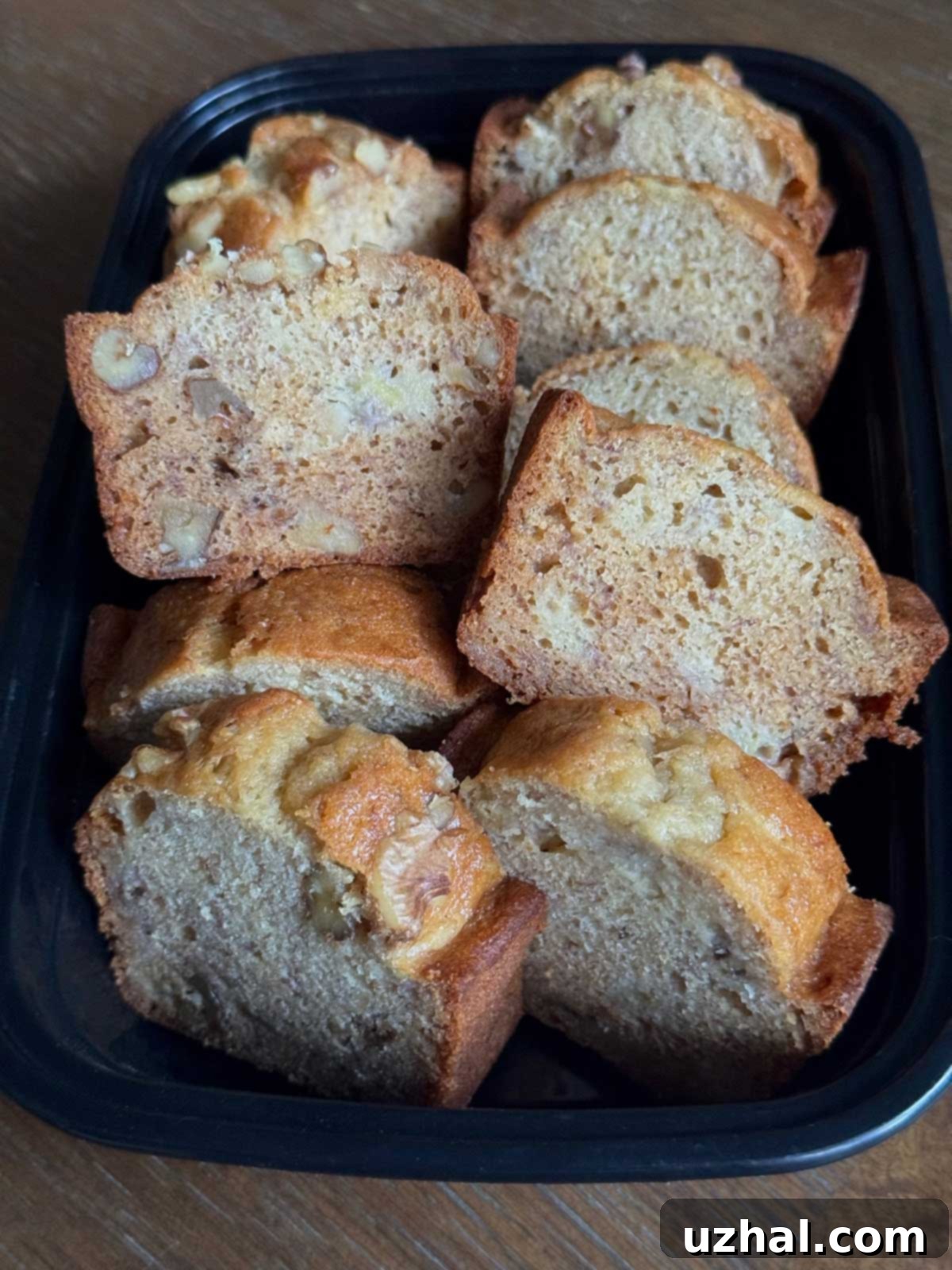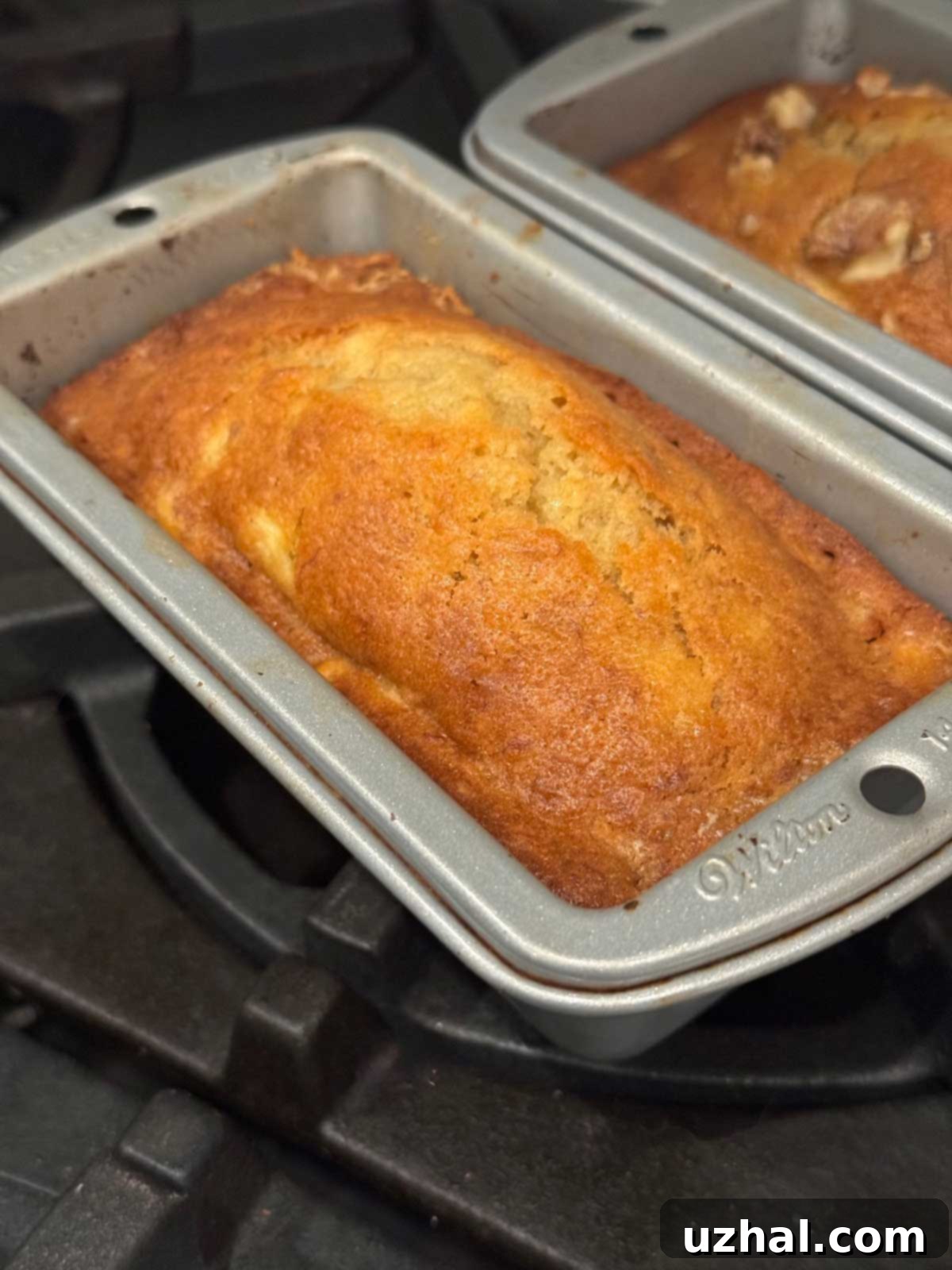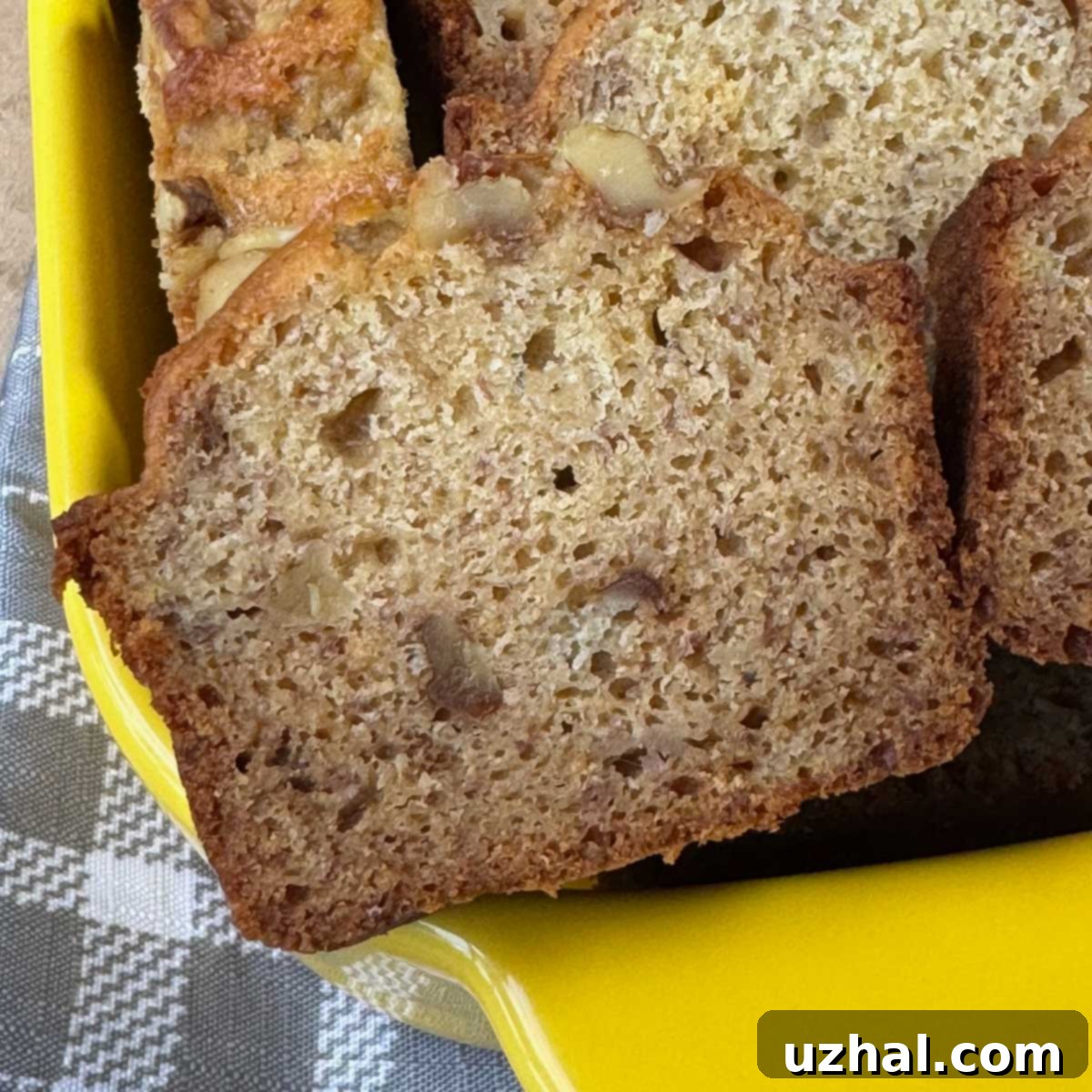Delicious Allulose Buttermilk Banana Bread: A Healthier Twist on a Classic Recipe
There’s something uniquely comforting about a warm slice of homemade banana bread. The aroma alone can transport you back to childhood kitchens, filled with the promise of a sweet, tender treat. While classic banana bread recipes often call for generous amounts of sugar, many home bakers are now seeking healthier alternatives without compromising on taste or texture. This is where the magic of allulose comes in. We’re taking a beloved classic – a rich, moist buttermilk banana bread – and giving it a modern, healthier twist by sweetening it entirely with allulose. If you’ve been curious about baking with alternative sweeteners, this recipe is an excellent place to start, promising delicious results that might just surprise you.

Understanding Allulose: Texture, Flavor, and Health Benefits
Allulose, a rare sugar found naturally in small amounts in foods like figs, raisins, and wheat, has emerged as a game-changer for those looking to reduce sugar intake. It’s an excellent choice for baking, and I’ve personally had consistently positive experiences using it. While traditional sugar undoubtedly holds its status as the ‘gold standard’ for its unique browning and structural properties, allulose comes remarkably close, offering a fantastic alternative sweetener that genuinely tastes good. Its chemical structure allows it to function much like sugar in recipes, contributing to volume, texture, and mouthfeel without the high caloric impact or glycemic response.
Allulose Texture and Flavor in Baking
One of allulose’s most notable characteristics in baking is its tendency to keep baked goods exceptionally soft. For certain items, like crunchy cookies or brittle, this might be a limitation, as it doesn’t promote the same crisp crystallization as sucrose. However, when it comes to banana bread, this property is a significant advantage, transforming what could be a dense loaf into a wonderfully tender and moist crumb. You’ll find that allulose-sweetened banana bread has a delightful chewiness and a soft, pillowy texture that perfectly complements its rich flavor. This softness also contributes to a longer-lasting moistness, preventing the bread from drying out too quickly.
Regarding flavor, some individuals report a slight bitter aftertaste with allulose. While I occasionally detect a faint hint of bitterness, it is remarkably subtle and far more palatable than the distinct ‘cool-mouth-feel’ often associated with erythritol. The good news is that the complex, sweet, and slightly spiced flavor profile of banana bread tends to mask any potential bitterness from the allulose, allowing the natural goodness of the ripe bananas and warm spices to shine through without distraction. For many, allulose offers a clean sweetness that is very close to sugar, making it an ideal substitute in recipes like this one. Therefore, whether you choose to make this buttermilk banana bread with allulose for its reduced sugar benefits or stick to the traditional method with granulated sugar, you’re in for a truly delightful treat.
Why Choose Allulose for Banana Bread?
Beyond its textural benefits, allulose offers several compelling reasons to use it in your baking, especially for a staple like banana bread:
- **Reduced Calories:** Allulose contains only about 0.4 calories per gram, significantly less than sugar’s 4 calories per gram. This means a substantial reduction in the overall calorie count of your banana bread without sacrificing taste.
- **Low Glycemic Impact:** As a rare sugar, allulose is not metabolized by the body in the same way as common sugars. It has a negligible effect on blood glucose and insulin levels, making it an excellent choice for individuals managing diabetes or those on a low-carb or ketogenic diet.
- **Similar Functionality to Sugar:** Unlike some other alternative sweeteners that don’t bake well, allulose performs much like sugar. It browns, caramelizes (though more quickly, as noted below), and contributes to the structure and volume of baked goods, ensuring your banana bread has the familiar characteristics you love.
- **Tooth-Friendly:** Allulose is not fermented by oral bacteria, which means it doesn’t contribute to tooth decay, offering an advantage over traditional sugar.

Buttermilk Banana Bread Notes: The Secrets to a Perfect Loaf
This recipe delivers a quintessential American-style banana bread, elevated by a few key choices that ensure superior flavor and texture. Unlike many simpler recipes that rely on oil, our version features unsalted butter, which is creamed with the sweetener (either sugar or allulose) using an electric mixer. This creaming process is crucial for incorporating air into the butter and sweetener mixture, leading to a lighter, more tender crumb that oil-based recipes often lack. Butter also contributes a richer, more complex flavor profile and a desirable moistness that perfectly complements the sweet bananas, creating a truly irresistible loaf.
The Role of Buttermilk and Proper Mixing
The dry ingredients—all-purpose flour, baking powder, baking soda, and salt (with optional cinnamon for an added layer of warmth)—are whisked together thoroughly before being alternately added with the buttermilk. This alternating addition, starting and ending with the dry ingredients, helps to develop the gluten just enough to create structure without making the bread tough or chewy in an undesirable way. Buttermilk, a star ingredient here, plays a vital role beyond just adding moisture. Its acidity reacts with the baking soda to create carbon dioxide gas, which helps the bread rise beautifully and achieve its characteristic fluffy, tender texture. Furthermore, buttermilk tenderizes the crumb by breaking down gluten strands and imparts a subtle, pleasant tang that balances the sweetness of the bananas beautifully, adding depth to the overall flavor.
The Importance of Adding Bananas Last
A critical tip for achieving the perfect banana bread crumb is to add the mashed bananas last. Introducing bananas too early in the mixing process can release their significant moisture content into the batter prematurely, potentially overhydrating the gluten. This can result in a dense, rubbery, or even gummy texture, which is far from the light and airy loaf we’re aiming for. By folding them in at the very end, gently and just until evenly blended, you ensure that the crumb remains light, airy, and wonderfully moist, allowing the rich, sweet banana flavor to be the undisputed star of your bread. This method also helps to prevent overmixing, another common pitfall that can lead to a tough banana bread.
Essential Tips for Baking with Allulose
For those eager to experiment with allulose in this recipe (I highly recommend the Durelife brand for its consistent quality and excellent results), here are some detailed tips to help you achieve the best possible outcomes and understand how this unique sweetener behaves in your kitchen:
- **Expect Softness (and Embrace it for Banana Bread!):** Allulose does not crystallize in the same way as traditional table sugar. This means your baked goods will almost invariably turn out softer, with a more tender and moist crumb. While this characteristic is a huge advantage for moist banana bread, fluffy cakes, or soft muffins, it’s something to consider if you’re aiming for a crispy or crunchy texture in other recipes, such as certain types of cookies or brittle candies. For those specific applications, you might find that a different alternative sweetener, such as an erythritol or monk fruit blend, will help achieve a firmer, crispier result. But for this banana bread, the softness is a feature, not a bug!
- **Adjusting for Sweetness Levels:** Allulose is approximately 70% as sweet as granulated sugar. To achieve a comparable level of sweetness in your final product, you will need to use a slightly higher quantity of allulose than you would sugar. A reliable rule of thumb is to use about 1 ⅓ cups of allulose for every 1 cup of sugar specified in a recipe. This adjustment ensures that your banana bread will have the perfect sweetness balance without being bland or overwhelmingly sweet. Always taste your batter if possible (before adding eggs, of course) to gauge sweetness, though this ratio is generally a good starting point.
- **Enhancing Muted Flavors:** One subtle difference with allulose is its tendency to mute or subtly dampen other flavors in a recipe, whereas sugar often acts as a flavor enhancer, making other ingredients pop. The simple and effective solution is to slightly increase the amount of flavorings you use. For instance, if a recipe traditionally calls for 1 teaspoon of vanilla extract and you’re baking with allulose, consider boosting that to 1 ¼ to 1 ½ times the original amount. This trick works wonderfully for other extracts, warm spices (like the cinnamon in our banana bread), or citrus zests, ensuring your final product is bursting with the vibrant flavors you expect.
- **Faster Browning – Adjust Temperature Accordingly:** Allulose caramelizes more rapidly than sucrose (table sugar) and will cause baked goods to brown more quickly. This means you might notice your banana bread developing a rich, golden-brown crust sooner than you would with a sugar-sweetened version. If you prefer a less intensely browned crust, or if your oven tends to run hot, a smart adjustment is to lower the baking temperature by 25 degrees Fahrenheit (about 14 degrees Celsius). For this buttermilk banana bread, however, a beautiful, deep brown crust is actually quite desirable as it adds to both the visual appeal and provides a slight textural contrast, so I typically leave the oven temperature at 350°F (175°C) to achieve that perfect golden exterior without burning. Keep an eye on it, especially towards the end of baking.
- Keto Chewy Chocolate Chip Cookies
- Lower Calorie Bran Muffins
- Deep Dish Keto Brownies with Allulose
- Reduced Fat Chocolate Muffins Recipe
- Bran Banana Bread
Buttermilk Banana Bread Recipe
Get ready to bake a wonderfully moist and flavorful banana bread that offers the best of both worlds: a classic comforting treat with a modern, healthier sweetener option. This versatile recipe allows you to choose between traditional granulated sugar or allulose, providing flexibility for your dietary preferences. Whether you opt for a single large loaf or several charming mini loaves, this buttermilk banana bread is designed to be easy to follow and incredibly rewarding. The inclusion of rich butter and tangy buttermilk ensures a tender crumb and a depth of flavor that’s hard to beat. Let’s get baking!

Buttermilk Banana Bread
Anna
Pin Recipe
Ingredients
- 2 cups all-purpose flour (250 grams)
- 1 teaspoon baking powder
- ½ teaspoon baking soda
- ½ teaspoon salt
- ¾ teaspoon cinnamon (optional) optional
- 1 cup granulated sugar or 1 ⅓ cups allulose (200 grams sugar )
- ½ cup unsalted butter, softened (114 grams)
- 1 teaspoon vanilla extract or 1 ½ if using allulose
- 2 large eggs, room temperature at room temperature
- 2-3 large ripe bananas, mashed to make 1 (240 grams)
- ½ cup buttermilk, room temperature
- 1 cup walnut pieces
Instructions
-
Preheat your oven to 350°F (175°C). Prepare your loaf pan(s) by generously greasing and flouring an 8 ½ by 4 ½ inch loaf pan, or four mini loaf pans (approximately 3×5 inches each). This crucial step helps prevent sticking and ensures a beautiful, evenly browned crust.
-
In a large bowl, whisk together the dry ingredients: flour, baking powder, baking soda, salt, and the optional cinnamon. It’s essential to mix these ingredients very thoroughly at this stage. Since the batter will be quite thick once the liquids are added, it becomes challenging to ensure even distribution without overbeating, which can lead to a tough bread. So, take your time and whisk well!
-
In the bowl of a stand mixer fitted with the paddle attachment (or using a hand mixer), combine the softened unsalted butter with your chosen sweetener (granulated sugar or allulose). Beat these together on medium-high speed until the mixture is light, fluffy, and creamy, typically 2-3 minutes. Stop and scrape down the sides of the bowl to ensure everything is well incorporated. Add the eggs one at a time, beating just until each egg is blended before adding the next. Finally, beat in the vanilla extract until combined.
-
With the mixer on low speed, alternately add the dry flour mixture and the room temperature buttermilk to the wet ingredients, beginning and ending with the flour mixture. Mix only until just blended, using a heavy-duty rubber scraper to fold the ingredients from the bottom up to ensure no dry pockets remain. Be careful not to overmix. Lastly, gently fold in the mashed bananas until they are just evenly blended throughout the batter. This helps keep the crumb tender.
-
If you are using walnuts (or other add-ins like chocolate chips), gently stir them into the batter at this point until evenly distributed.
-
Transfer the prepared batter into your loaf pan(s). For a large loaf, bake for about 60 minutes. Begin checking for doneness around the 60-minute mark; a wooden skewer or toothpick inserted into the center should come out clean. For mini loaves, bake for 35 to 40 minutes, checking at the 35-minute mark. If using allulose, keep an eye on the browning as it tends to caramelize faster.
-
Once baked, remove the pan(s) from the oven and let them cool on a wire rack for 10 minutes. This allows the bread to set. After 10 minutes, carefully loosen the edges of the bread with a knife. Allow it to cool in the pan for another 30 minutes before inverting it onto the wire rack to cool completely. Slicing too early can result in a gummy texture.
Notes
Nutrition
Serving and Storage Suggestions
Once your delicious Buttermilk Banana Bread has cooled completely, it’s ready to be enjoyed! This moist loaf is wonderful on its own, perhaps with a steaming cup of coffee or a comforting mug of tea for a cozy breakfast or an indulgent afternoon snack. For an extra touch of decadence, consider spreading a thin layer of softened butter, a dollop of cream cheese, or even a light dusting of powdered sugar on a slice. It also pairs beautifully with fresh berries or a scoop of vanilla ice cream for a dessert.
To keep your allulose-sweetened banana bread fresh and moist, store it at room temperature in an airtight container. Because allulose helps maintain softness, your bread will remain wonderfully tender for up to 3-4 days. If you live in a particularly humid climate, or if you plan to keep it longer, refrigeration can extend its freshness for up to a week. For longer-term storage, you can easily freeze individual slices or the entire loaf (once completely cooled) by wrapping it tightly in plastic wrap and then in aluminum foil. Thaw frozen slices at room temperature for an hour or two, or gently warm them in the microwave for a quick, comforting treat. This recipe is perfect for meal prepping and having a healthy, homemade snack readily available.
Get Creative: Variations and Additions
While this Buttermilk Banana Bread recipe is fantastic as is, don’t hesitate to get creative with additions to customize your loaf and make it uniquely yours. The robust flavor of banana bread lends itself well to various mix-ins:
- **Chocolate Lover’s Delight:** For those who adore chocolate, folding in a cup of chocolate chips (dark, semi-sweet, or even sugar-free chocolate chips if you’re adhering to the allulose theme) alongside the mashed bananas would be a truly delightful choice. The pockets of melted chocolate add another layer of sweetness and texture.
- **Nutty Enhancements:** If you’re a fan of nuts, beyond the suggested walnuts, pecans or even a mix of nuts like almonds or hazelnuts would work beautifully. Toasting your nuts lightly before adding them can enhance their flavor and crunch.
- **Dried Fruit Fun:** Incorporate dried cranberries, chopped dates, raisins, or even shredded coconut to add lovely texture and additional flavor dimensions. Remember that dried fruits are naturally sweet, so they can complement the allulose nicely.
- **Spice It Up:** Beyond cinnamon, consider adding a pinch of nutmeg, ground cloves, or a touch of ginger for a warmer, more complex spice profile. A dash of cardamom can also introduce an exotic, fragrant note.
Just remember to fold in any additions gently at the very end of the mixing process, ensuring they are evenly distributed without overmixing the batter, which is key to maintaining a tender crumb.
Conclusion: Enjoy Your Healthier Banana Bread Journey
Baking with allulose offers a wonderful opportunity to enjoy your favorite treats with a significantly reduced sugar content, and this Buttermilk Banana Bread recipe stands as a prime example of its success. The unique properties of allulose contribute to an incredibly moist, tender, and flavorful loaf that truly rivals its sugar-sweetened counterparts. It allows you to indulge in that comforting homemade taste without the guilt associated with high sugar intake, making it a perfect choice for health-conscious individuals or those exploring sugar alternatives.
Whether you’re making it for a healthier breakfast, a satisfying guilt-free snack, or to share with friends and family, this Buttermilk Banana Bread with allulose is sure to become a cherished addition to your baking repertoire. Don’t hesitate to embrace the experiment, follow these tips, and discover the delicious and wholesome possibilities of allulose in your kitchen. Happy baking!
